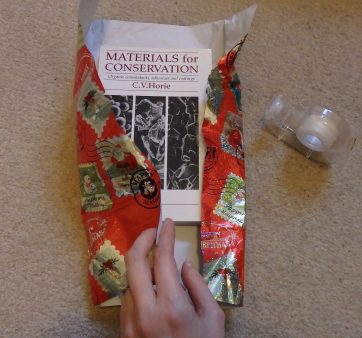All about Sellotape
24 December 2017
As I sit down to write this blog post, many people will be gathering gifts, wrapping paper, and Sellotape in preparation for the festive period. But as you wrap, or even unwrap your gifts, spare a thought for the self-adhesive clear tape often used to fasten those pretty parcels.
Sellotape?
Whether we call it Sellotape, Scotch® tape, sticky tape, tape or something else, most of us have grown up using pressure sensitive tape, and over the years I have certainly applied tape without giving it a second thought. The Sellotape and Scotch® brands have been around since the 1930s, and since then they have created many thousands of different products.
As an MSc Conservation Practice student in my first year, I was recently assigned a black and white photograph in need of conservation. The photograph had been attached to a piece of cardboard using Sellotape along three edges to hold it in place. While we don’t know when this ‘mount’ was created, the cardboard is likely to date from the mid 1960s (due to the font of the branding used on the reverse side), so the tape could be anything up to 50 years old. Over that time the tape has become severely discoloured and brittle, with some of it lifting up. My task will be to carefully remove this tape, but before I do so I need to fully understand what Sellotape consists of.
What is pressure sensitive tape?
Tape typically consists of four layers and uses many different raw materials:
The bottom layer is the adhesive, which in older tapes consisted of a natural or a synthetic rubber, but in the case of Scotch® Magic™ Tape is now an acrylic polymer originating from crude oil (ACS 2007). The adhesive may also contain plasticisers, softeners, and curing agents (AIC 1987) to help to create a workable product and one that sticks effectively. The next layer is a primer, often consisting of natural or synthetic polymers such as rubber, which ensures that the adhesive and the backing film stick firmly together. On top of this is the familiar backing film or ‘carrier’, which has been made from a range of materials over time from paper, to cellophane, to foil, and cellulose acetate. Cellulose acetate originates from wood pulp, which is broken down using chemicals and physical force to obtain the cellulose from the pulp, and then added to a plasticiser and made into sheets of film (ACS 2007). Finally, there is a release coat, which enables the tape to be unwound from its roll without leaving behind a sticky residue on top of the backing film.
So why is tape a problem?
In most cases, when pressure sensitive tape is first applied it sticks well to surfaces but it can also be peeled off fairly easily and without leaving a residue behind. Indeed, I confess to having previously saved pretty wrapping paper after unwrapping a gift, by carefully peeling off the tape! However, as tapes age, the adhesive polymers begin to deteriorate and this can have an impact upon the surfaces in contact with the adhesive.
As mentioned earlier, the adhesive in older tapes is more likely to have been made from a synthetic or natural rubber, which doesn’t age particularly well. Over time, oxidation occurs, which is where radicals within the adhesive polymer react with oxygen and form peroxides and hydroperoxides (Horie 2000, p.34). These products can be broken down by light and heat, which results in further oxidation and even cross-linking between polymer chains (if the side-chains of the polymers are oxidised). At first, the adhesive becomes sticky and oily and it starts to yellow, but as cross-linking occurs, it becomes tough and brittle, with even more discolouration (AIC 1983). This often results in staining on the surface beneath the tape, and removal of the residue and stain is then increasingly difficult.

Therefore, the removal of pressure sensitive tape can be a complex process, depending upon the age of the tape, how it was manufactured, and the surface to which it has been applied. This is just one of the many challenges faced by conservators, and one which I am looking forward to tackling in the New Year at Cardiff University.
References:
AIC (the American Institute for Conservation). 1983. Pressure-Sensitive Tape and Techniques for its removal from paper. Available at: https://cool.conservation-us.org/coolaic/sg/bpg/annual/v02/bp02-13.html [accessed 21/12/2017].
ACS (American Chemical Society: National Historic Chemical Landmarks). 2007. Scotch®Transparent Tape. Available at: https://www.acs.org/content/acs/en/education/whatischemistry/landmarks/scotchtape.html [accessed 21/12/2017].
Ergener. S. 2012. Sellotape: why it’s bad to put on paper, and removal. Available at: https://www.westdean.org.uk/study/school-of-conservation/blog/books-and-library-materials/sellotape-why-its-bad-to-put-on-paper-and-removal [accessed 21/12/2017].
Horie C.V. 2010. Materials for Conservation, Organic Consolidants, Adhesives and Coatings. Butterworths. 2nd edition.
All photos by Mandy Garratt
- March 2024 (1)
- December 2023 (1)
- November 2023 (2)
- March 2023 (2)
- January 2023 (6)
- November 2022 (1)
- October 2022 (1)
- June 2022 (6)
- January 2022 (8)
- March 2021 (2)
- January 2021 (3)
- June 2020 (1)
- May 2020 (1)
- April 2020 (1)
- March 2020 (4)
- February 2020 (3)
- January 2020 (5)
- November 2019 (1)
- October 2019 (1)
- June 2019 (1)
- April 2019 (2)
- March 2019 (1)
- January 2019 (1)
- August 2018 (2)
- July 2018 (5)
- June 2018 (2)
- May 2018 (3)
- March 2018 (1)
- February 2018 (3)
- January 2018 (1)
- December 2017 (1)
- October 2017 (4)
- September 2017 (1)
- August 2017 (2)
- July 2017 (1)
- June 2017 (3)
- May 2017 (1)
- March 2017 (2)
- February 2017 (1)
- January 2017 (5)
- December 2016 (2)
- November 2016 (2)
- June 2016 (1)
- March 2016 (1)
- December 2015 (1)
- July 2014 (1)
- February 2014 (1)
- January 2014 (4)
